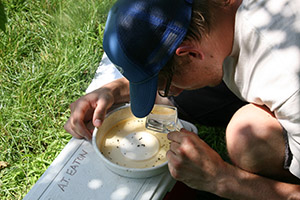Growers, Scientists Tackle Spotted Wing Drosophila
 |
|
Ross MacKeil identifies SWD catch in a Londonderry, NH, orchard. Source: A. Eaton, Univ. of NH |
A vineyard owner who runs a small operation remembers the day when he took some softened grapes to the Hudson Valley Laboratory for analysis. The entomologist there found 17 young flies under the skin of the first berry. “They just poured out,” the owner recalls.
The culprit: spotted wing drosophila (SWD), a small vinegar fly about three millimeters in length. The male of the species has dark spots on the wing tips. The female uses its large, serrated ovipositor to saw into healthy, ripe fruit such as raspberries, blueberries, blackberries, strawberries, grapes, and late-season peaches, all crops in high demand in the Northeast. First detected in California in 2008, the invasive insect has disrupted fruit production as it has swept eastward since then. High rainfall and humidity in the Northeast have been favorable to SWD. Plus, there’s an abundance of wild hosts. Entomologist Peter Jentsch of Cornell University estimates that growers in the Northeast could lose tens of thousands of dollars per farm each year as they try to manage SWD.
Reason for Hope
Alan Eaton, an entomologist at the University of New Hampshire, determined that through the efforts of New England collaborators, growers in New Hampshire alone were able to reduce their losses from $1.5 million in 2012 to $526,000 a year later.
The Northeastern IPM Center awarded about $215,000 for SWD research in the region in 2013, including a Regional IPM Competitive Grant of $175,000 to Cesar Rodriguez-Saona, a scientist at Rutgers University, for research on sustainable management of SWD. In 2014 the Center funded the SWD Working Group with a grant of $10,000. The Working Group met in September of 2014 in Highland, New York to coordinate research and extension activities and set priorities for the region.
Probing a Variety of Questions
Is it better to place traps on the edge of farm fields, in the woods near fields, or in the fields themselves? Jentsch is studying Beauveria bassiana, a fungus that grows naturally in soils throughout the world, which could control SWD larvae. Dale Ila Riggs, a grower who runs the Berry Patch and leads the New York State Berry Growers Association, is testing netting on a large scale to exclude SWD. Her prototype contraptions look like high tunnels made of netting.
Meanwhile, scientists are trying to determine the best bait and trap design to control SWD.
Dean Polk of Rutgers said a fermentation product (flour and yeast in apple cider vinegar) is the best type of bait, followed by Trécé, a commercial lure. He says researchers have not yet developed threshold limits for SWD management, because trap catches are inconsistent relative to infestation in fruit.
Recommendations
One grower recommends getting more susceptible varieties of fruit out locally and quickly. Pick every day. (But then, labor costs increase.)
The vineyard owner in the Hudson Valley recommends cleaning the floor of the vineyard, not composting on the ground to avoid creating a breeding habitat for SWD.
It’s important to properly manage pomace, the pulpy residue remaining after fruit has been crushed in order to extract its juice. Don’t put this back next to the crop. Either put a sheet of plastic over it to solarize it or spread it over a field with a manure spreader so it will dry out faster.
Richard Cowles of the Connecticut Agricultural Experiment Station recommends an SWD trap made by placing a whole wheat mixture in a vented, sealed cup inside a second, larger cup. For more on SWD traps, see the sidebar, right.
For more recommendations including identification, monitoring, and chemical options that can help manage SWD, visit:
— by CHRIS GONZALES
The Northeastern IPM Center promotes integrated pest management for reducing risks to human health and the environment. If republishing our news, please acknowledge the source (“From Northeast IPM Insights”) along with a link to our website.
